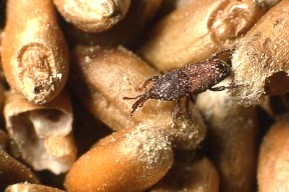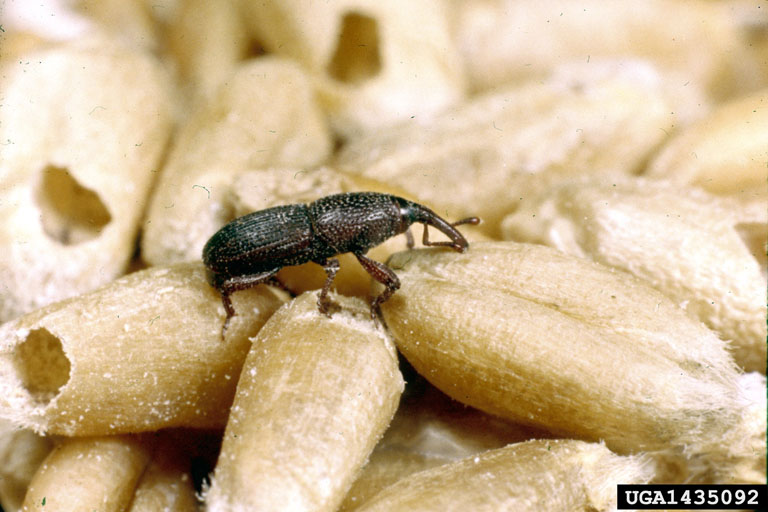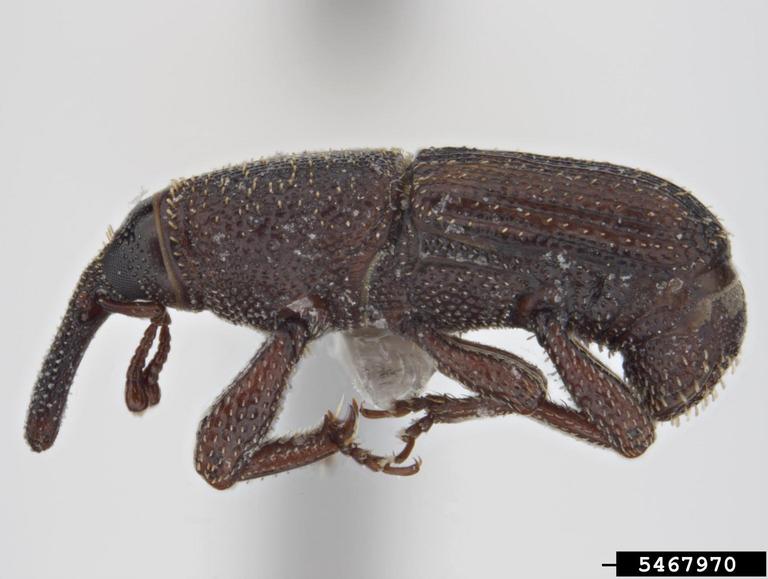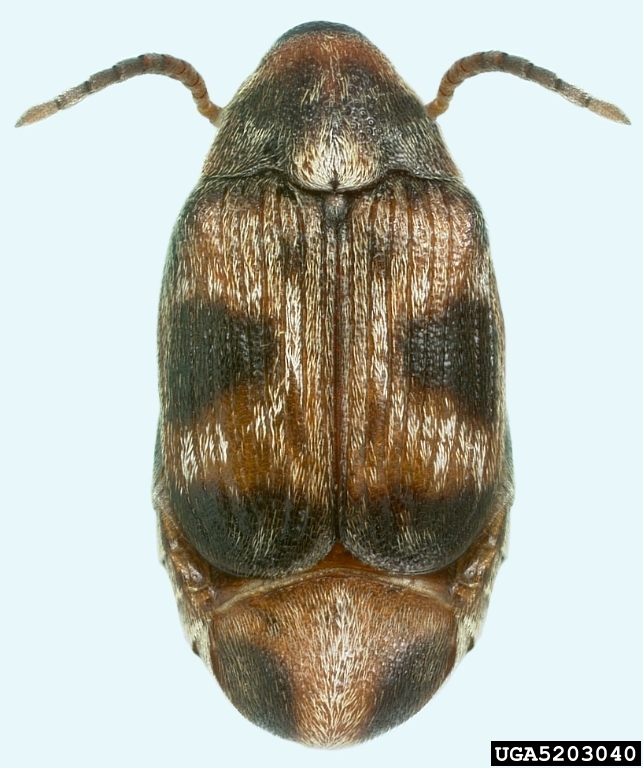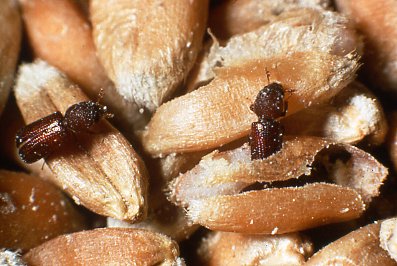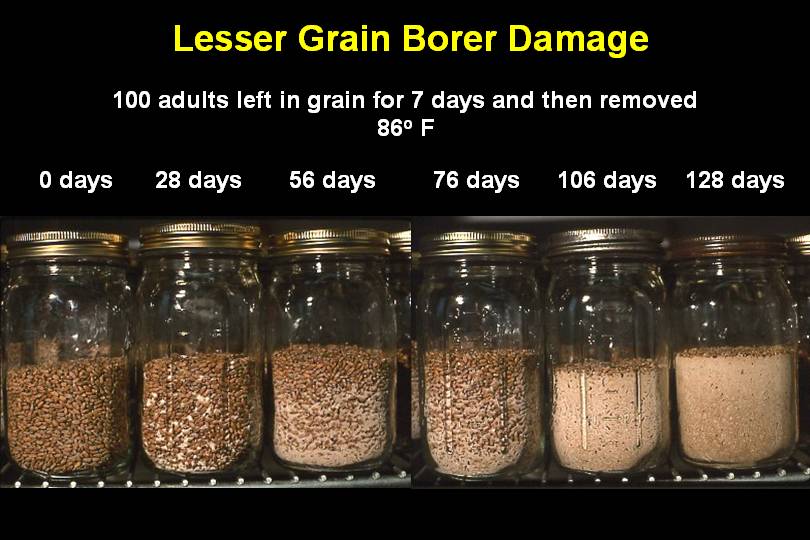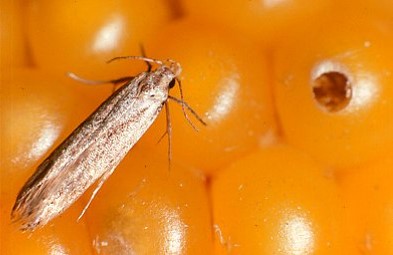Stored Grain Insect Pests that Feed Inside Kernels and Seeds
- Jump To:
- Grain Weevils
- Grain Borers
- Grain Moths
- Control
Stored grain insects may cause a serious threat to grain and seed stored for several months. Significant loss in both grain and seed quality and quantity may occur. It is critical to know what type of insect pests may potentially infest the grain and seed.
Insect pests of stored grain and seed fall into two catego-ries: internal feeders and external feeders of grains or seeds. This fact sheet is focused on the internal feeders that feed on whole grains where the larvae live inside the kernels and seeds causing damage. The damage created by these insects may lead the producer to realize a discount fee at the time of sale if there are 32 or more insect damaged kernels (IDK) in a 100 g sample of grain.
Internal feeding insect pests of stored grain and seed feed upon intact, whole kernels. After the eggs are laid in, on or loosely among the kernels and seeds, the larvae burrow into them causing damage within the kernels and seeds where it is not observable. An infestation is known only when adult insects are observed or holes in the kernels are detected.In Oklahoma, there are seven main insect pests that are internal feeders and these occur in three insect groups: grain weevils, grain borers and grain moths.
Grain Weevils
Rice Weevil
The rice weevil, Sitophilus oryzae, is a small beetle with a snout (Figure 1). It averages about 3/32 of an inch in length. The color of this insect varies from a dark reddish brown to a very dark brown or nearly black and the forewings are usually marked with four reddish or yellowish colored spots. It has functional wings under the elytra, or hardened forewings, and can fly although most of the time it walks. The thorax, or mid-section of the insect body, is densely pitted with longitudinally elliptical punctures with a puncture-free zone near the midline of the pronotum, the prominent plate-like structure that covers all or part of the thorax.
Adult rice weevils and the other grain weevils prefer grain that is at least 12.5 percent moisture and they live an average of four to five months. A female lays 300 to 400 eggs during her lifespan. The female uses her mandibles, or mouth parts, at the end of her snout to bore a small hole into the grain kernel. She then turns around and lays a single egg in the hole and covers it with a secreted gelatinous material that hardens and plugs the hole, protecting the egg and later the larva. When the larva emerges from the egg, it burrows directly inside the kernel. The larva continues to feed inside the kernel until it pupates and then chews its way out of the kernel leaving a hole. The shape of the hole is a jagged-edged circle. During ideal weather conditions, the life cycle is about 25 to 35 days.
Figure 1. Rice weevil on wheat. (Photo courtesy Edmond Bonjour)
Granary Weevil
The granary weevil, Sitophilus granarius, is a small dark-colored beetle with a snout (Figure 2). The size of this insect is about 3/16 of an inch or smaller. It does not have functional wings and can only walk from place to place. Its thorax is marked with oval or elongated punctures.
Granary weevil adults live an average of seven to 13 months, and each female lays 50 to 250 eggs during this period. The female lays its eggs similar to the rice weevil. The larva hatches from the egg and then consumes the interior of the kernel, pupates and emerges as an adult. The hole is jagged in shape. The life cycle from egg to adult is about 28 to 35 days.
Figure 2. Granary weevil on wheat. (Photo courtesy Clemson University – USDA Cooperative Extension Slide Series, Bugwood.org)
Maize Weevil
The maize weevil, Sitophilus zeamais, is slightly larger than the previous two weevils measuring about 1/8 to 3/16 inch in length (Figure 3). It is generally darker in color than the other two weevils although there is some degree of variation within all three species, so color makes them difficult to tell apart. The maize weevil has functional wings like the rice weevil but is a stronger flier. The thorax is densely and uniformly pitted with round punctures.
Its life cycle is similar to the rice weevil. The maize weevil has a slightly slower rate of development at about 30 to 35 days from egg to adult. Adults live about four to eight months. In the southern part of the U.S., this insect will infest corn ears on stalks in the field.
Figure 3. Maize weevil. (Photo courtesy Pest and Disease Image Library, Bugwood.org)
Cowpea Weevil
The cowpea weevil, Callosobruchus maculatus, is not a true weevil because it lacks a snout (Figure 4). Adults are reddish brown and about 1/8 inch in length. They have two blackish red spots on the wing covers, which are shorter than their abdomen, or body. There are also two blackish spots on the exposed portion of the abdomen. Adults are short-lived (10 to 14 days) and do not feed.
This insect is a pest on legumes and lays its egg in the pods in the field or on seeds in storage. Eggs are laid directly on the seed and a female can lay 20 to 70 eggs during her life, depending on temperature. Larvae burrow into the seed and feed on the contents. Larval feeding occurs very close to the surface of the seed, leaving a thin covering called a window that is about 1/16 inch in diameter. The average development time under ideal conditions is 26 days.
Figure 4. Cowpea weevil. (Photo courtesy Natasha Wright, Cook’s Pest Control, Bug-wood.org)
Bean Weevil
The bean weevil, Acanthoscelides obtectus, is also not a true weevil because adults lack a snout (Figure 5). They are primarily a pest on beans and can infest both in the field before harvest or on beans in storage. The adults are grayish-brown in color, 1/8 to 3/16 inches in length, short-lived (14 days or less) and do not feed. The adults have brown or grayish spots on the wing covers and fine yellow-orange hairs on the thorax.
A female bean weevil may lay up to 70 eggs during her lifetime. Total development time is 32 days under optimum conditions and longer (90 days) under cooler temperatures.
Figure 5. Bean weevil. (Photo courtesy Pest and Disease Image Library, Bugwood.org)
Grain Borers
Lesser Grain Borer
The lesser grain borer, Rhyzopertha dominica, is a small beetle about 1/8 inch in length (Figure 6). It is cylindrical in cross-section and the head is not visible when viewed from above because it is tucked under the thorax. It is dark red-dish brown in color with a slightly roughened surface. It has a 10-segmented antenna, which is clubbed with the last three segments greatly enlarged.
The female lays 300 to 500 eggs in her lifetime and deposits them singly or in clusters amongst the kernels. When the eggs hatch, the larvae bore into the kernels and the rest of their development occurs within the kernel. The adult emerges from a nearly perfectly round hole that it has chewed through the kernel. Their life cycle takes about 25 days under ideal conditions.
Adult lesser grain borers are strong fliers and have been captured up to two miles from the point of release. The adults are long lived, up to one year, and the feeding of both the larvae and adults produce a large quantity of powdery residue (Figure 7).The larger grain borer, Prostephanus truncatus, is an-other internal pest of stored grain but it is only a pest in more tropical areas and is not found in Oklahoma.
Figure 6. Lesser grain borers on wheat. (Photo courtesy Edmond Bonjour)
Figure 7. Lesser grain borer damage on wheat through time. (Photo courtesy Edmond Bonjour)
Grain Moths
Angoumois Grain Moth
The Angoumois grain moth, Sitotroga cerealella, is a small buff- or tan-colored moth with a wing span of about ½ to 5/8 inch (Figure 8). The wings have a feathery appearance and are often called fringed. Adult moths are short-lived, generally less than one week, and do not feed. The larvae cause all the damage.
Under normal conditions, a female will lay an average of 40 to 150 eggs. The female moth can infest grain in the field before harvest. Eggs are laid on wheat heads, on exposed tips of corn ears or on the surface layer of stored grain because the adults are unable to penetrate deeply into a grain mass. The larvae emerge from the egg and chew a hole in the kernel no larger than a pin prick through which it enters the kernel. It consumes the inside of the kernel until pupating. The mature larvae eats a channel to the outside of the kernel and makes a weakly fastened flap at the exit by cutting the shell ½ to ¾ of the circumference of a circle. After pupation, the adult moth emerges through this nearly perfectly round hole (Figure 9) and often leaves a pupal case protruding from the kernel. The complete development time is about five weeks.
There are many other moths that infest grain, but they are not internal feeding and do not cause IDK.
Figure 8. Angoumois grain moth on wheat. (Photo courtesy Edmond Bonjour)
Figure 9. Angoumois grain moth and emergence hole on popcorn. (Photo courtesy Edmond Bonjour)
Control
There is a critical need to know when these insects are present in stored grain. If found, it is necessary to control them because of their ability to cause IDK that may lead to discounts when selling and marketing grains and seeds. More information on preparing storage structures prior to harvest and insecticides used in and around stored grain facilities can be found in the following two Oklahoma Cooperative Extension Service Fact Sheets: BAE-1112, Preparing Grain Bins and Flat Storages Prior to Harvest or Incoming Product Storage and EPP-7098, Grain Protectants and Top-dress Treatments for Stored Grains
Edmond L. Bonjour
Associate Extension Specialist - Stored Products Entomologist

